








fff
Kathleen Gill’ is a holistic nurse, energy therapist, stress management specialist and beekeeping hobbyist who has recently turned her “yawn lawn” at home in the Beachview section of Stafford Township into a pollinators’ paradise, i.e. a natural habitat meadow by Native Designs of Jackson.
The process combines science, agriculture and horticulture to achieve a sustainable, whimsical yard that is welcoming to pollinators, who are vital contributors to the well-being of the environment as a whole and all its inhabitants, people included.
Through pollination, bees play a vital role in foods such as nuts, berries, vegetables and fruits. Plants need bees, flies, beetles, butterflies, hummingbirds and bats in order to produce seeds or fruit. Because land development in New Jersey has destroyed many flowering native plants and critical habitat, bees need help, especially in summer and fall, to find enough flowering plants to forage.
“European turf grass is not natural,” Gill said. “It doesn’t want to grow here.” Many lawns are treated with chemical fertilizers, and the runoff upsets the balance of the ecology of the bay.
By contrast, she said, a native yard is sustainable; requires no maintenance, as plants naturally come back after the winter; fights weeds; and provides food for pollinators.
Native Designs’ Danny Epperly earned his degree in ornamental horticulture and environmental design from Delaware Valley University. He said yard transformations are becoming more common for properties close to the coast, e.g. Island Heights and Lavallette; Gill was his first client in Stafford.
Prior to beginning any project, in order to understand the land he’s working with, Epperly performs a site analysis to identify different areas of the yard. (At Gill’s, some places are wetter, more sandy, or have a high clay content.) He also considers the climate, traffic, and soil hydrology. He then selects native plants and grasses specifically for their adaptability to the soil surrounding the home.
Matching the plants to the habitat keeps weed pressure low, Gill explained. The plants are densely intermingled, but not in competition, because they operate at different levels and are easy to manage, she said. “With the right plants, we can push vegetative composition in the direction we want and therefore eliminate weeds and the need for gas-powered mowers,” she added.
To begin, Epperly first excavated the sod, then raked the soil out in preparation to plant a combination of hundreds of nursery plants and seed mix (this is the right time to seed, he noted); and nature will do the rest of the work, as wind takes the seeds and sends them elsewhere to germinate.
The whole process takes less than a week.
Afterward, the meadow needs some monitoring, to check on seed growth and watering, he said, maybe an occasional trimming back here and there to encourage root growth.
“Our local honeybees are just a few months away from a meadow habitat, with footpaths and walkways between the swaying grass and flowers,” Gill said. Her property also provides habitat for butterflies, bats, purple martins, other birds, and mason bees, which don’t make honey but pollinate like pros.
In the transformation from lawn to meadow, one way to go is to kill the existing grass first with glyphosate, but Gill was opposed to that idea, as well as to the soil tilling which would follow, so she opted for neither of those techniques but for a more natural overall process. Lifting the sod instead would keep weed growth down.
It’s not cheap, Gill said, but it’s an investment in nature and the whole community.
In a staging area of her yard, dozens of nursery plants were lined up and ready to go into the ground, with more on the way: asters, goldenrod, bee balm, coneflower, marigold, black-eyed Susan, yarrow, ornamental grasses. A witch hazel tree would join the lineup, as many more plants would arrive later in the week. In total the new meadow would cover a little under an acre, or about 70 percent of Gill’s property.
For Epperly, working the earth with his hands is a passion – but all the outdoor exposure takes a toll.
“I’m allergic to what I do,” he admitted. Weekly allergy shots help to keep the worst of the symptoms at bay – but pollen season is bad for everyone, he said. Moreover, the discomfort that comes with the territory is a small pay price to pay for the reward of seeing a project like Gill’s come to life and knowing the good it does for the environment, he said. “I love what I do,” Epperly said.
He noted a lot of people have the wrong idea about bees, confusing honeybees and other non-threatening garden varieties for yellow jackets and wasps.
Honeybees sting only defensively; they get upset when you take their honey, Gill explained. So, as a general strategy for beekeeping (and for life), the best defense is not to offend. “You go in there with your suit, your smoker, and you only take what the bees don’t need,” she said.
Two years ago Gill took an eight-week introductory course offered by the Rutgers Cooperative Extension of Cape May County, the Jersey Cape Beekeepers Association and the state Department of Agriculture to learn basic beekeeping. Her mentors were Steve and Margaret Woodford of Brookville Bee Farm in Barnegat. (The difference between a farmer and a hobbyist is a minimum acreage requirement.)
Her interest was initially sparked by hearing about the declining bee population and its consequences, and further stoked by an eye-opening documentary called “Queen of the Sun.”
“There is so much to learn,” she said.
For Gill, a beekeeping practice is a peaceful endeavor – slow, quiet, mindful and observant.
But, no doubt about it, raising bees is dicey. Beekeepers must learn to protect the hive from extreme heat and drought, disease, starvation, queen loss and even bears or skunks. Hive losses are to be expected, though solving the mystery is harder.
Honeybees have also been declining drastically in the last decade due in part to Colony Collapse Disorder, which is not yet fully understood. The debated causes of the nationwide honeybee decline range from climate change and habitat loss to pesticide use, which decreases their immune systems, to varroa mite infestation and the toxicity of electromagnetic frequencies.
Bee boxes and starter kits can be found pretty readily online. Gill purchased her “nuc,” or starter kit, comprised of a queen and 20,000 bees, from Portland, Ore. From her hives she produces Bee Grateful honey. Gill adores her bees, whom she calls her girls, and, what’s more, she admires their behavior and the lessons they could teach humanity: They’re selfless, democratic, hard workers and good communicators.
Homeowners can start a bee yard with a single hive, she said. The greater the number of hobbyist beekeepers, the better the odds of survival and diversity.
In the beekeeping community, Gill said, it is thought to be better for 20 people each to have one hive than for one person to have 20.
But even where a bee yard is not practical, a native plant meadow is still an option. A container garden full of perennials is a step in the right direction. “Additionally,” Gill suggests, “reduce, rethink or eliminate pesticides and fungicides in your garden, and provide a fresh-water drinking supply for the pollinators – a shallow bowl of water with rocks and sticks in it so they won’t drown.”
Some native perennials Gill listed as beneficial to pollinators are New England aster, mountain mint, sundial lupine, bee balm, cardinal flower, goldenrod, butterfly weed, swamp milkweed, anise hyssop, catnip, marigold, yarrow, sunflower, zinnia, spearmint and lavender.
Gill would love to see the meadow idea catch on.
“It is a very exciting and daring initiative to help our pollinators,” she said, “and I am hoping this may be of interest to other homeowners who are leaning into eco-conscious ways to help the bees and butterflies and, yes, to save the planet, one lawn at a time.”
For more information about Native Designs, email Epperly at nativedesigns1@gmail.com or phone 732-604-5707.
— Victoria Ford
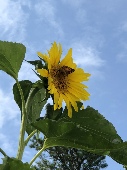
Advise from a honey bee
Create a buzz ~ Sip life's sweet moments ~
Mind your own beeswax ~ Work together ~
Always find your way home ~
Bumbles happen now and then ~
Bee yourself!


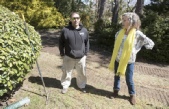
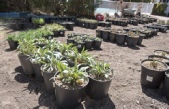
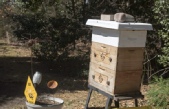
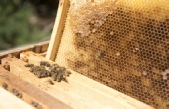





Double Click Image to see full size.
Photos by: Ryan Morrill
Copyright: The Sandpaper.net April 12, 2019 - Story by Victoria Ford